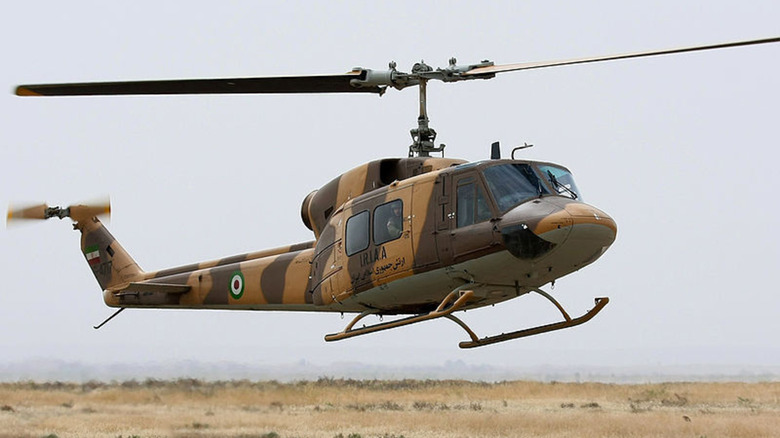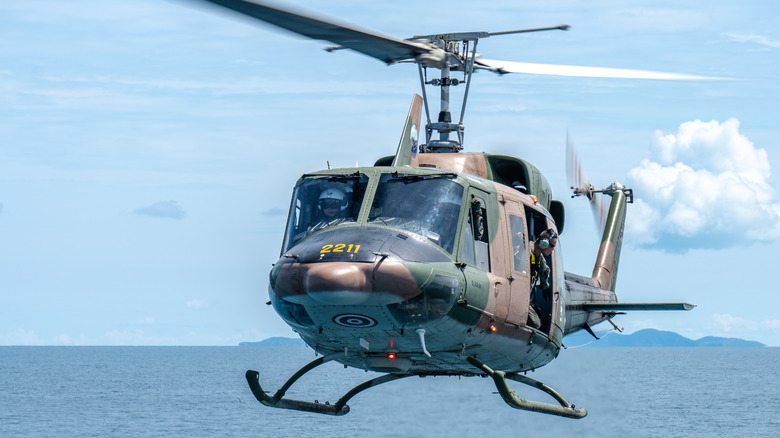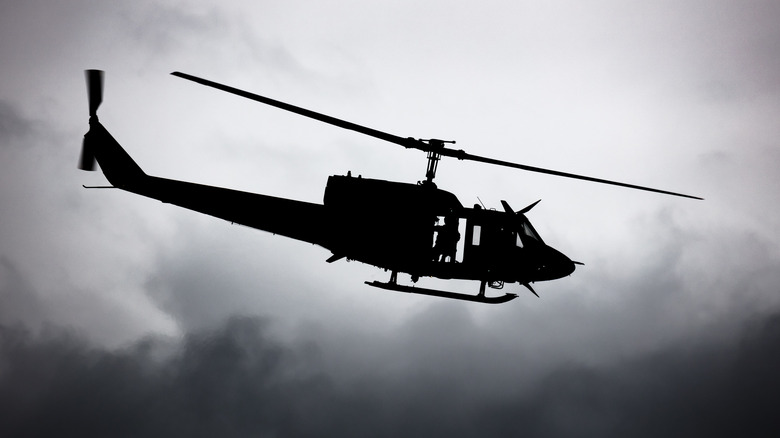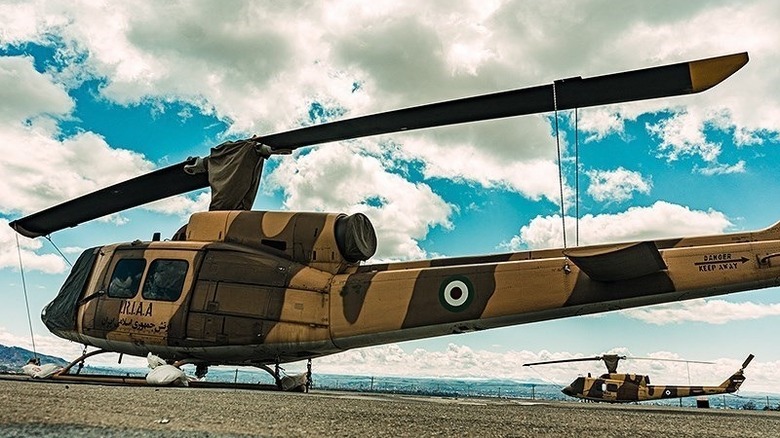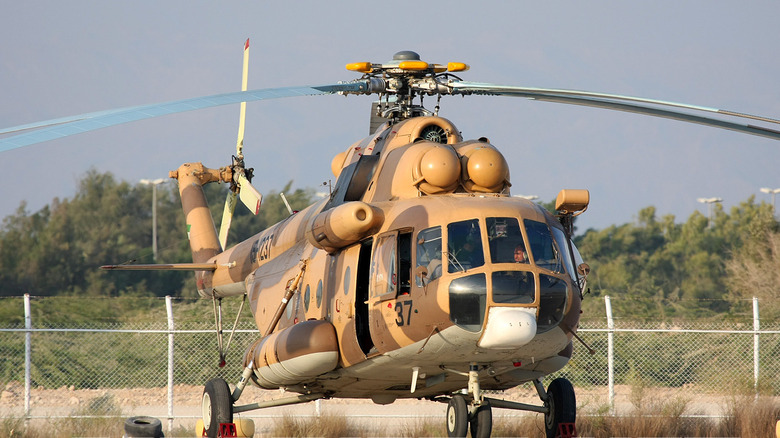The Spotty Safety Record Of The Helicopter That Crashed Carrying The President Of Iran
Over the weekend, a Bell 212 helicopter operated by the Islamic Republic of Iran Air Force went missing in the mountainous area of Iran's East Azerbaijan province. Seven total were onboard including the Iranian President Ebrahim Raisi, Iran's Foreign Minister Hossein Amir-Abdollahian, East Azerbaijan province governor Malek Rahmati, and religious leader Ayatollah Mohammad Ali Al-e Hashem. After a day of searching, complicated by a thick fog that's suspected to be a contributor to the incident, a crash site was found with no survivors.
This incident ignited a political firestorm and raised questions about the circumstances that led to the accident. Most of the attention has centered on the ill-fated Bell 212 helicopter itself.
The age – between 30 and 50 years old depending on different estimates from open-source intelligence sources — is just one of the several concerning details about the helicopter. For starters, the 6-9207 may not have been instrument-rated, meaning the helicopter shouldn't have flown in the intense foggy conditions on the morning of the crash. Moreover, international sanctions on spare parts mean the odds that the old Bell 212 received proper maintenance were slim. With all that in mind, the decision to fly not one, but several high-ranking officials on such an aircraft was nothing short of bewildering.
[Featured image by Shahram Sharifi via Wikimedia Commons | Cropped and scaled | CC BY-SA 4.0]
Background on the Bell 212
Originally developed by Bell Helicopter, now a division of Textron Inc., in the 1960s as an export version of the American UH-1 Iroquois for the Canadian government, the 212 was a derivative model for the civilian market. Over the years, the Bell 212 was bought and put into service by over 60 countries worldwide. The Washington Post reported — per analysis from an aviation firm called Cirium — that although mass production stopped in 1998, there are as many as 443 Bell 212s still operating worldwide.
One of the key features of the Bell 212 is its twin-blade rotor powered by two Pratt & Whitney PT6T turboshaft engines — an upgrade from the original UH-1's single turboshaft. The combined power of the two engines allows the helicopter to carry external payloads of up to 5,000 pounds or, in a passenger-carrying capacity, accommodate up to 15 people.
Early versions of the Bell 212 were rated only for Visual Flight Rules (VFR), which means the pilot must rely on visual cues for navigation. In bad weather or poor visibility conditions, these VFR-rated helicopters are to remain grounded. Later, the Bell 212 received an Instrument Flight Rules (IFR) rating, allowing pilots to fly in adverse weather conditions using only their instruments. However, the cockpit had to be overhauled with new avionics to be certified – an upgrade that 6-9207 potentially did not see.
The Accident-Stricken Bell 212 may have been Unequipped for the Task
According to open-source intelligence analysts, 6-9207 might've been VFR-rated only. The weather conditions in East Azerbaijan province that day were foggy with visibility of less than five meters, wherein instrument flight is mandated. If all these details proved to be true, 6-9207 shouldn't have been flying.
Adding to the challenges, the region is experiencing very cold weather, with temperatures hovering around 45 degrees Fahrenheit. Operating a helicopter in cold conditions can be demanding, as ice buildup can impair visibility, reduce control, and diminish engine power. Furthermore, situated in a valley, the terrain can cause harsh and unpredictable wind conditions, making the route treacherous.
To be clear, the Bell 212 is capable of operating at high altitudes, with a service ceiling of around 17,300 feet when properly maintained. That is well above the crash site's altitude at 7,200 feet. However, given the age and questionable maintenance history of the 6-9207, there are heavy doubts on whether it could safely navigate the route at all, weather notwithstanding.
Iran blames Sanctions for the Crash
In the aftermath, former Iranian Foreign Minister Mohammad Javad Zarif has placed the blame squarely on the United States, citing the extensive sanctions imposed on Iran as a cause for the crash in an interview with the Associated Press. It may seem like a game of blame-shifting on a geopolitical enemy, but the argument is not technically without merit.
Since the Iranian Revolution in 1979, which overthrew the Shah of Iran, the U.S. government and its allies have imposed numerous sanctions on the country, including restrictions on aircraft parts. Bell Textron, the division that manufactured the Bell 212, has stated that they neither conduct business nor support the Iranian helicopter fleet, according to the Financial Times. Reports also suggest that these aging helicopters were often flown without proper safety checks, further compounding the risks of failure.
The IRIAF inherited over 300 Bell helicopters from the Imperial Iranian Air Force. However, due to the scarcity of spare parts, the fleet has dwindled significantly. According to the FlightGlobal 2024 World Air Forces report, the IRIAF's Bell 212 fleet was reduced to just ten airframes before this crash.
[Featured image by Tasnim News Agency via Wikimedia Commons | Cropped and scaled | CC BY-SA 4.0]
Alternatives Exist but Weren't Chosen
Raisi's habit of touring the country via helicopter was well-documented. In 2023, a leaked memo addressed to Mohammad Mokhber, the Vice President of Iran, revealed plans to purchase two Mi-171A2 helicopters for around $32 million.
In the past, Raisi has been photographed walking down from a Mi-171 operated by the Iran Revolutionary Guard Corp (IRGC). While it remains unclear whether it was one of the helicopters discussed in the memo, one thing is certain: the Mil Mi-171 is cleared for VIP transport duties.
The Mi-171 is a more powerful and, most importantly, IFR-rated aircraft. Spare parts would be a non-issue for the Mi-171 since it's produced by key Iranian ally Russia and wouldn't be affected by Western-led sanctions. With foul play now ruled out in the crash investigation, the IRIAF now has a lot of tough questions that it must answer about the decision to send so many officials in such an old helicopter into dangerous conditions. It will have to answer if negligence from flight planners was to be blamed for the crash.
[Featured image by Shahram Sharifi via Wikimedia Commons | Cropped and scaled | GFDL 1.2]
